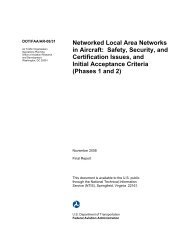Published Report (DOT/FAA/CT-94-36)
Published Report (DOT/FAA/CT-94-36)
Published Report (DOT/FAA/CT-94-36)
Create successful ePaper yourself
Turn your PDF publications into a flip-book with our unique Google optimized e-Paper software.
5.3.2 Technical Observer Assessment.<br />
The technical observers concluded that the triple approach<br />
operation at DIA could be conducted safely, based upon their<br />
observations of controller and system performance. The technical<br />
observers reported that controllers had little difficulty<br />
detecting and resolving blunders for this operation. It was<br />
noted that the controllers used the F'MA alerts to their<br />
advantage, and often used the additional lead time in determining<br />
the optimal evasion maneuver.<br />
5.3.3 TWG Assessment.<br />
Based on the established test criteria, the TWG concluded that<br />
the controllers met the simulation objective. The arrival<br />
monitor positions in the simulation proved to be operationally<br />
effective and feasible.<br />
Based on the results of the simulation, the TWG concluded in its<br />
operational assessment (appendix K) that the proposed triple<br />
simultaneous ILS approaches at DIA are acceptable, achievable,<br />
and safe with the FMA system and an appropriate radar system,<br />
such as a Mode S monopulse system or an ASR-9 system enhanced to<br />
provide improved target resolution capabilities.<br />
Based on their operational assessment, the MPAP TWG made three<br />
recommendations: 1) there should be one monitor controller for<br />
each runway; 2) monitor positions should be located adjacent to<br />
one another; 3) a radar system with 2.7 milliradians azimuth<br />
accuracy or better and the capability to resolve two aircraft at<br />
20 nmi separated by 0.9 degrees or more should be used.<br />
5.4 RISK ASSESSMENT.<br />
A risk assessment was conducted on the data from the simulation.<br />
Since there is no recorded operational data about blunders, this<br />
analysis determined a target risk value, and then computed a<br />
blunder rate which would result in the target risk value. This<br />
assessment was based on NTSB data for the total number of air<br />
carrier accidents, as well as the number of fatal accidents on<br />
final approach. A risk model was developed, and it was<br />
determined that about ten 30-degree blunders per 10,000 triple<br />
parallel simultaneous approaches could be tolerated for the risk<br />
of the operation to meet the target risk level. Thus, the risk<br />
assessment indicated that the DIA operation meets the target risk<br />
of 4 x lo-' approaches.<br />
6. CONCLUSIONS.<br />
This simulation tested the controllers ability to effectively<br />
resolve conflicts for the proposed triple simultaneous instrument<br />
landing system (IS) operation at the new Denver International<br />
45

















